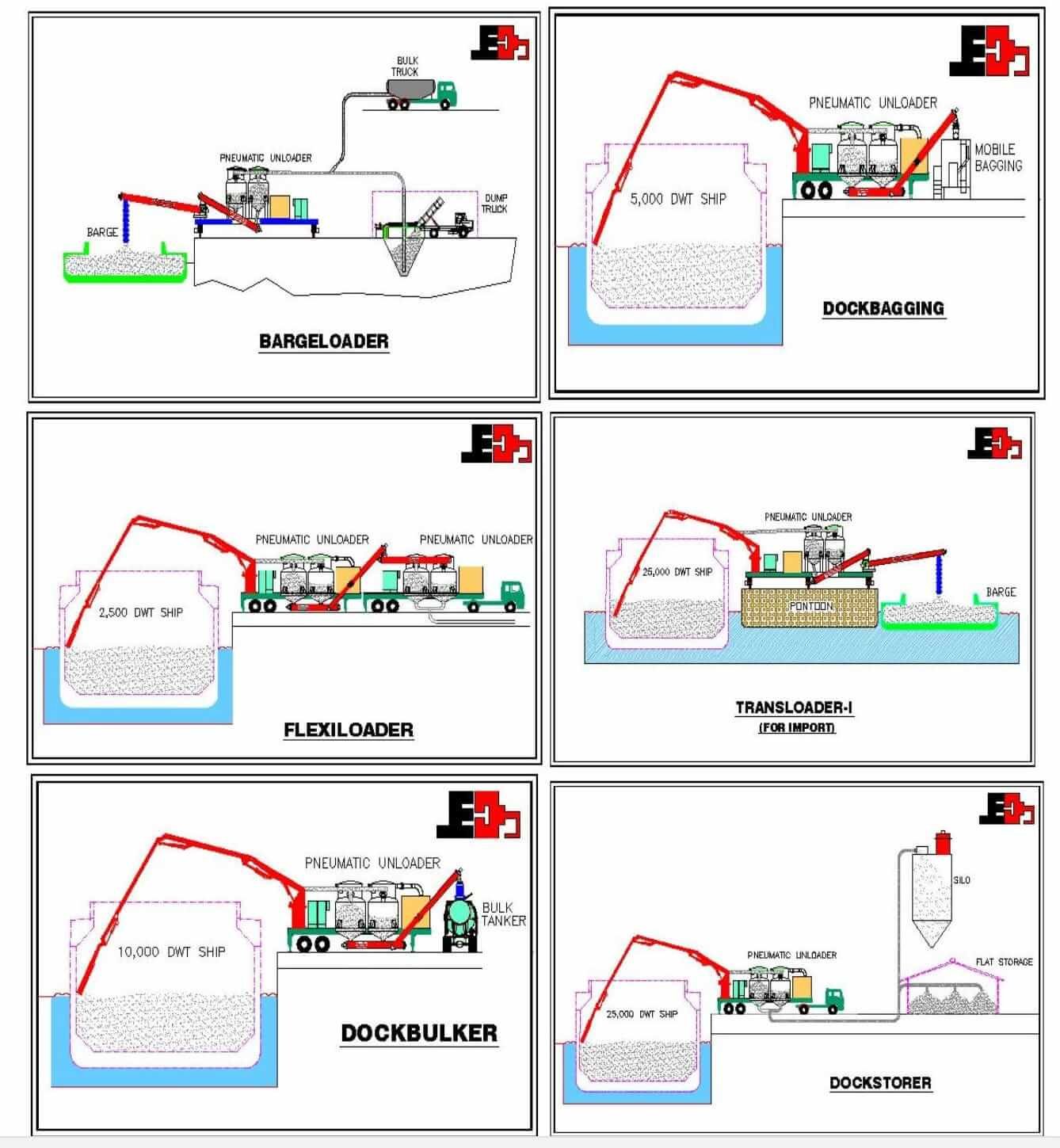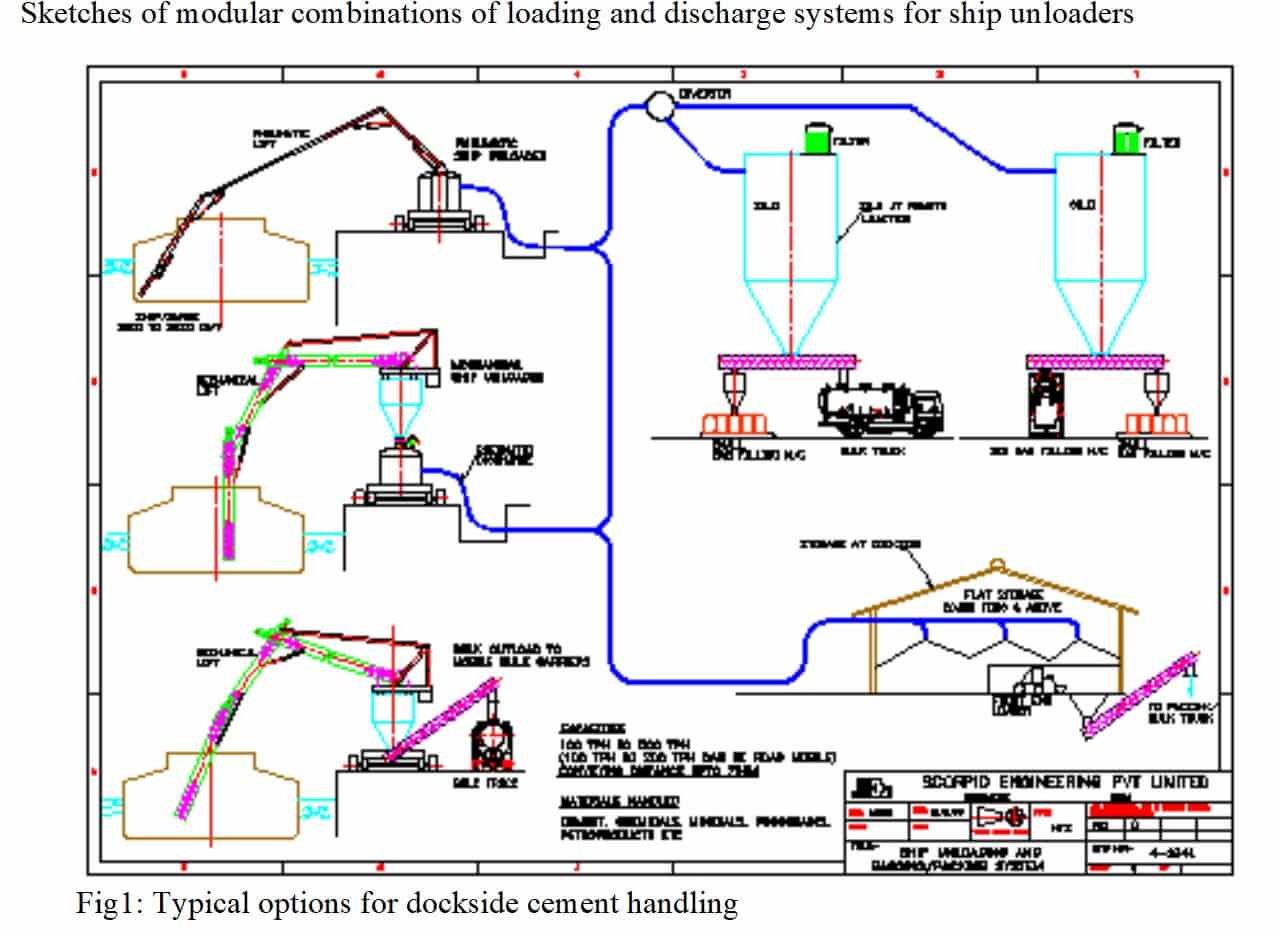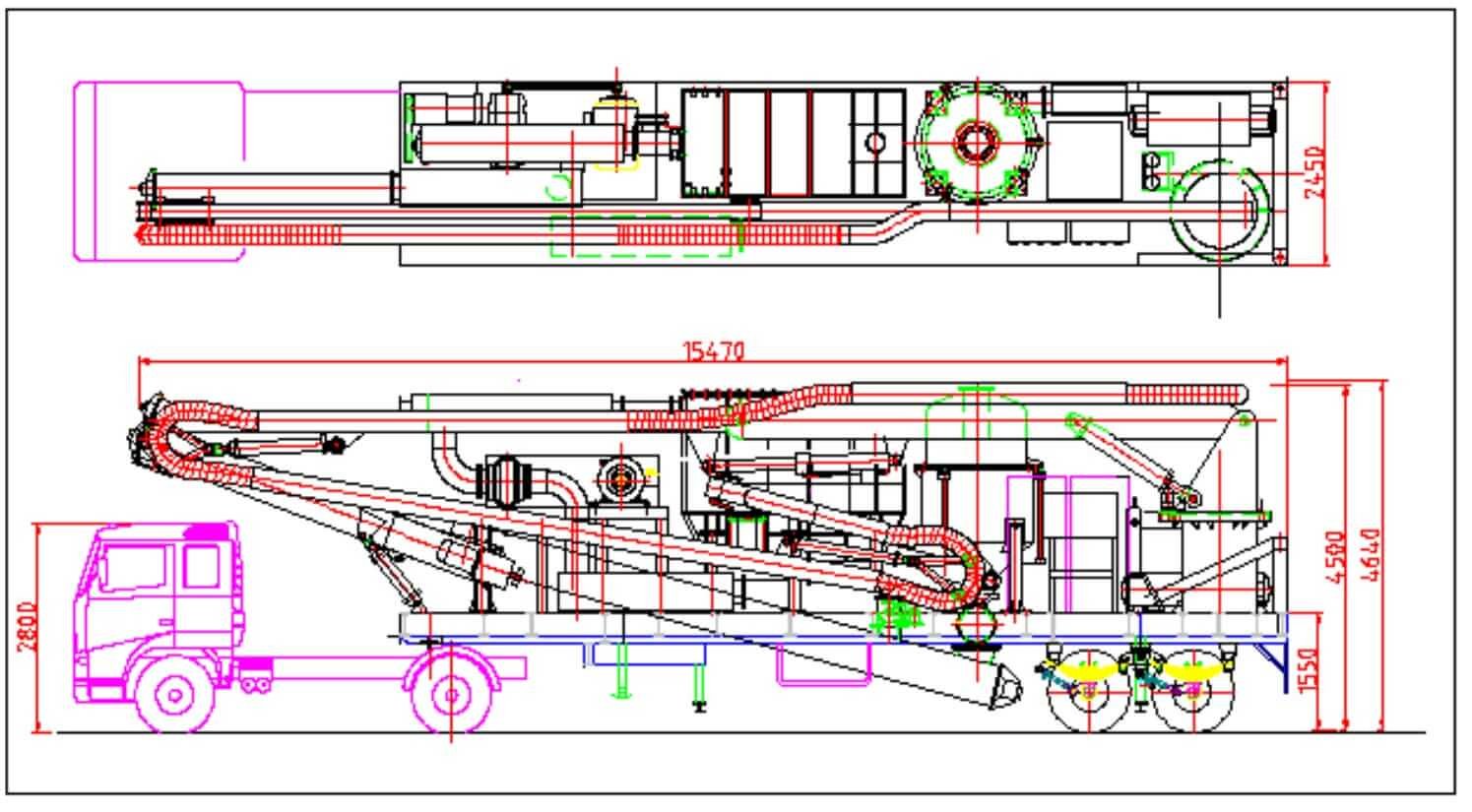Hello there!
With India embracing lightning speed development in port infrastructure, port planning will become imperative to ensure efficient progress. This article looks at bulk port terminals.
The lowest cost method of transport of bulk materials is in bulk by sea. Shore based terminals are now becoming larger and soon we will see the arrival of giant bulk handling terminals for the ocean receipt and inland distribution of many dry free flowing bulk materials. Many countries have now made it compulsory for imports to be in bulk to avoid the wastage and pollution associated with the large volume management of bagged bulk materials. The flexibility and low cost of bulk terminals enables low cost operations in the management of dry bulk materials. This paper will look at some of the salient features of bulk terminal operations.
DOCKSIDE SYSTEMS:
BAGGING UNITS: Bulk materials which are bagged immediately on receipt on shore will have the lowest cost conversion of bulk to discrete bagged units as there is no intermediate storage or handling between ship and packing plant. Dockside bagging has therefore come to stay. Manufacturers will however need to look at reliable and high capacity dockside bagging systems since these systems are currently the bottleneck for large volume dockside bagging. This is because of the need for such bagging units to be mobile as dock authorities will not allow permanent or semi-permanent installations on the jetty. Currently, most mobile bagging stations are limited to a capacity of 60 to 80 TPH in 4 or 5 in-line packing configurations. If these units are placed on the dockside for bagging, the upstream feeding units (mobile ship unloaders) from the ship will have to be of similar capacities. However, mobile pneumatic ship unloader costs per tonne of material are lower for higher tonnages of unloading. A compromise is therefore required to achieve the best economic combination of ship unloader capacity and ship size, bagging capacity remaining the same. The best solution would be to have an optimum capacity ship unloader feeding to multiple dockside bagging units to achieve the economics of scale with ship sizes in the 5000 to 10000 DWT range.
SILOS: Where dockside bagging is not required and intermediate storage is permissible, dockside silos are generally installed about 300 to 500m away from the jetty on high soil bearing capacity surfaces. Mobile ship unloaders can in this case be of much higher capacities than those required for ship side bagging and can be rail or gantry mounted on the dockside.
Bulk materials filled in the silos from ship unloaders are bagged at much higher capacities than the mobile units deploying rotary packers instead of in-line packers. However, this would require a sizeable investment in support structures, offices, covered plant area etc. and would be a higher cost operation than the mobile bagging option. Nevertheless, economies of scale can reduce the per tonne cost of bagged materials in such fixed silo-based bagging plants when capacities are increased.
BULK TANKERS: In both options, it is also possible to feed bulk tankers with the bulk material unloaded from the ships.
While considering low cost options for dockside handling of bulk from ships and barges, one has to also look at complete terminal operations both import and export.
IMPORT TERMINALS:
Bulk terminals are built in a variety of sizes considering both yearly tonnages through them. Small terminals can be classified as those having a tonnage approx. 150000 to 200000 tonnes through them yearly. Large terminals will be 500000 to a million tonnes per year. We will specifically look at small terminals.
The primary function of the Import Terminal would be to enable fast unloading of incoming ships / barges and optimal movement of material in an acceptable form to the final user destination. A lot depends on the local market conditions. The market also determines the size of the ship that would be discharging at the facility. The most popular size of ship for long distance carriers is about 25000 to 30000 DWT. Panamax Vessels (60000 DWT) have still to become popular for carrying bulk since there are technical limitations in high capacity unloading of such large volumes from these vessels. If the terminal is envisaging arrival of small barges (2500 DWT) to large ships (30000 DWT), the design of the terminal becomes complicated. Single equipment to unload both sizes of vessels are generally not available and if available would be prohibitively expensive. Once the ship is unloaded, the storage arrangements have to be compatible with the throughput of the terminal. Hence the design of the terminal has to consider the best combination of incoming ship size, unloader type and capacity, storage method and packing facilities to enable lowest cost per tonne of product handled.
A number of combinations of equipment configurations can be made to arrive at an optimum modular fit for specific terminal throughputs.
A sketch is attached that shows a number of such modular options.


The primary equipment on the dockside for Import Terminal would be the unloader. For small terminals with dockside storage available, by far the most cost effective and efficient unloading method would be pneumatic in the range of 250 – 400 TPH. It would be prudent to employ two or more units of similar capacity to ensure flexibility and to insure against possible equipment down time. For larger terminals that can handle larger vessels, mechanical unloaders that can to upto 1000TPH for certain bulk materials like grain are available.
For pneumatic unloading, most terminal operators are by now aware that the rated capacity of the unloader should not be used to compute ship berthing times for the unloading operation. All pneumatic unloading operations have some inherent properties as follows:
1. High rate of unloading for the first 50 – 60% of the hold capacity.
2. Drop in unloading rate as the hold empties down to 80% with 20% material remaining.
3. Requirement of moving the final layer of material to mid hold heaps to enable final excavation by the suction unit. This generally requires the use of a small front end-loader which should be lowered into the holds.
4. Final manual sweeping of the holds clean.
Hence the average unloading rate (of critical importance to the terminal operator) would be lower than the rated capacity of the unloading unit considering repositioning of the unloading arm to different holds in addition to the above factors. There is what is known as a TTS capacity which is “Through-The-Ship” capacity which is what the terminal operator has to reckon with. The TTS capacity is dependent considerably on operator training and skill level, environmental conditions at the port,and crew cooperation and teamwork. A skilled and trained operator can achieve a TTS figure of about 70 – 80% of the rated capacity. When using relatively untrained and unskilled operators, the TTS can be as low as 50 – 65% of the rated capacity. There is also a learning curve that stabilizes after a few hours or after a day of commencement of the ship unloading operation.
Screw type unloaders can also be deployed to evacuate bulk materials from the holds of the ship provided a certain amount of breakage of the product is acceptable. However, the screw unit will not remove as much of the material towards the end of unloading as would the pneumatic unit. This is because of the need to effectively flood the screw with material at all times to maintain full capacity of the screws. While there are many devices that enable such flood feeding to take place, the rotating steel mass of the suction screw requires that the operator is careful not to touch the tank top. Operators are generally careful about this and keep considerably off the tank top thus requiring a large amount of hold cleanup by front end loaders and manual labour. In the pneumatic unloader however, the steel suction nozzle can be separately fitted with a flexible suction hose towards the end of unloading and this hose can be manouvered inside the hold to clean-out the final leftover material.
Once the material is unloaded from the holds through the pneumatic suction arm, it needs to be either filled into bulk trucks alongside the unloading unit or it has to be fed to some distance, say 500m, to stationary storage facilities at the dockside. A number of options for this operation which includes screw out-loads, dense phase pneumatic transfer, dilute phase pneumatic transfer etc are available. Keeping the pneumatic suction arm as a standard unloading method, modular attachments to the pneumatic unloading system can be made to perform any of the above discharge operations like bulk truck loading or disant silo or flat storage loading. Fig 1 gives typical options.

Part 2 of this article will cover export terminals and the equipment planning that will ensure flexibility so that the terminal can be used for both import and export!
Stay tuned!
